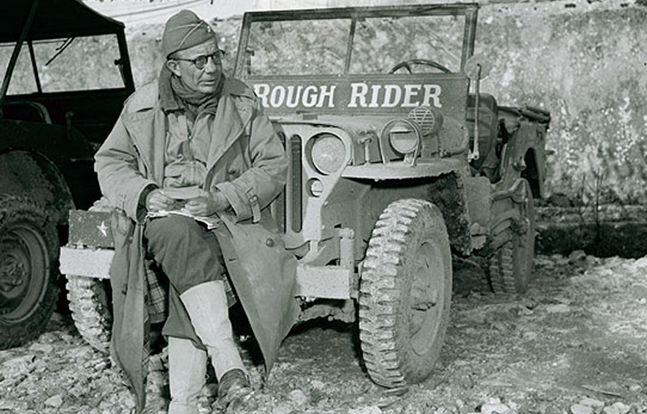On June 6, 1944–commonly known as D-Day–the Allies began a massive invasion of Europe, landing 156,000 British, Canadian, and American soldiers on the beaches of Normandy, France. The soldiers were met with fierce resistance from the German forces, but they persevered and eventually liberated France from Nazi control. In recognition of their bravery and sacrifice, several soldiers were awarded the Medal of Honor. Everyone knows the stories of how the troops fearlessly took the shores in France on D-Day, but there are hundreds of individual stories of bravery that many do not know.
The following dozen men received the Congressional Medal of Honor, the highest award that can be given to military personnel, for their efforts surrounding the events of D-Day.
BARRETT, CARLTON W.
Advertisement — Continue Reading Below
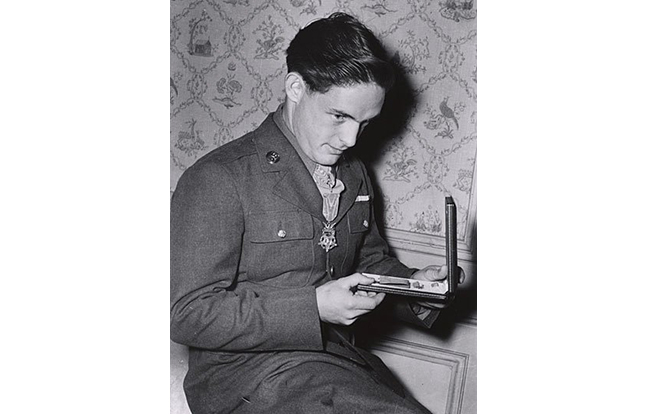
Rank and organization: Private, U.S. Army, 18th Infantry, 1st Infantry Division.
Place and date: Near St. Laurent-sur-Mer, France; June 6, 1944.
Entered service at: Albany, N.Y.
Advertisement — Continue Reading Below
Birth: Fulton, N.Y.
G.O. No.: 78, Oct. 2, 1944.
Citation: For gallantry and intrepidity at the risk of his life above and beyond the call of duty on D-Day, June 6, 1944, in the vicinity of St. Laurent-sur-Mer, France.
Advertisement — Continue Reading Below
On the morning of D-Day, Pvt. Barrett, landing in the face of extremely heavy enemy fire, was forced to wade ashore through neck-deep water. Disregarding the personal danger, he returned to the surf, again and again, to assist his floundering comrades and save them from drowning.
Refusing to remain pinned down by the intense barrage of small-arms and mortar fire poured at the landing points, Barrett, working with fierce determination, saved many lives by carrying casualties to an evacuation boat lying offshore. In addition to his assigned mission as guide, he carried dispatches the length of the fire-swept beach; assisted the wounded; and calmed the shocked. He arose as a leader in the stress of the occasion. His coolness and his dauntless daring courage while constantly risking his life during a period of many hours had an inestimable effect on his comrades and is in keeping with the highest traditions of the U.S. Army.
*BUTTS, JOHN E.
Advertisement — Continue Reading Below
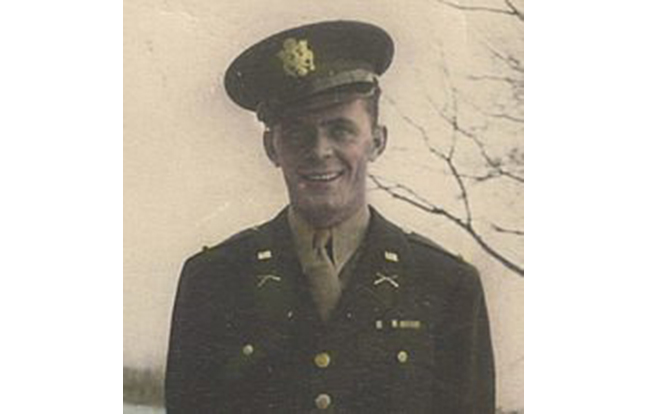
Rank and organization: Second Lieutenant, U.S. Army, Co. E, 60th Infantry, 9th Infantry Division.
Place and date: Normandy, France; June 14, 16 and 23, 1944.
Entered service at: Buffalo, N.Y.
Advertisement — Continue Reading Below
Birth: Medina, N.Y.
G.O. No.: 58, July 19, 1945.
Citation: Heroically led his platoon against the enemy in Normandy, France, on June 14, 16 and 23, 1944.
Advertisement — Continue Reading Below
Although painfully wounded on the 14th near Orglandes and again on the 16th while spearheading an attack to establish a bridgehead across the Douve River, he refused medical aid and remained with his platoon.
A week later, near Flottemanville Hague, he led an assault on a tactically important and stubbornly defended hill studded with tanks, antitank guns, pillboxes, and machinegun emplacements, and protected by concentrated artillery and mortar fire. As the attack was launched, 2d Lt. Butts, at the head of his platoon, was critically wounded by German machinegun fire.
Although weakened by his injuries, he rallied his men and directed one squad to make a flanking movement while he alone made a frontal assault to draw hostile fire upon himself. Once more he was struck, but by grim determination and sheer courage continued to crawl ahead. When within 10 yards of his objective, he was killed by direct fire. By his superb courage, unflinching valor, and inspiring actions, Butts enabled his platoon to take a formidable strong point and contributed greatly to the success of his battalion’s mission.
Advertisement — Continue Reading Below
*DEGLOPPER, CHARLES N.
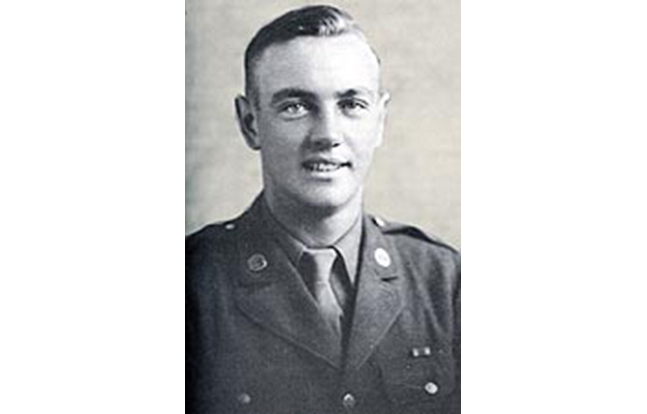
Rank and organization: Private First Class, U.S. Army, Co. C, 325th Glider Infantry, 82d Airborne Division.
Place and date: Merderet River at la Fiere, France; June 9, 1944.
Advertisement — Continue Reading Below
Entered service at: Grand Island, N.Y.
Birth: Grand Island, N.Y.
G.O. No.: 22, Feb. 28, 1946.
Citation: He was a member of Company C, 325th Glider Infantry, on June 9, 1944, advancing with the forward platoon to secure a bridgehead across the Merderet River at La Fiere, France – a mere three days after D-Day.
At dawn, the platoon had penetrated an outer line of machine guns and riflemen, but in so doing had become cut off from the rest of the company. Vastly superior forces began a decimation of the stricken unit and put in motion a flanking maneuver that would have completely exposed the American platoon in a shallow roadside ditch where it had taken cover. Detecting this danger, Pfc. DeGlopper volunteered to support his comrades by fire from his automatic rifle while they attempted a withdrawal through a break in a hedgerow 40 yards to the rear.
Scorning a concentration of enemy automatic weapons and rifle fire, he walked from the ditch onto the road in full view of the Germans and sprayed the hostile positions with assault fire. He was wounded, but he continued firing. Struck again, he started to fall, and yet his grim determination and valiant fighting spirit could not be broken. Kneeling in the roadway, weakened by his grievous wounds, he leveled his heavy weapon against the enemy and fired burst after burst until killed outright. He was successful in drawing the enemy action away from his fellow soldiers, who continued the fight from a more advantageous position and established the first bridgehead over the Merderet.
In the area where he made his intrepid stand his comrades later found the ground strewn with dead Germans and many machine guns and automatic weapons which he had knocked out of action. DeGlopper’s gallant sacrifice and unflinching heroism while facing unsurmountable odds were in great measure responsible for a highly important tactical victory in the Normandy Campaign.
EHLERS, WALTER D.
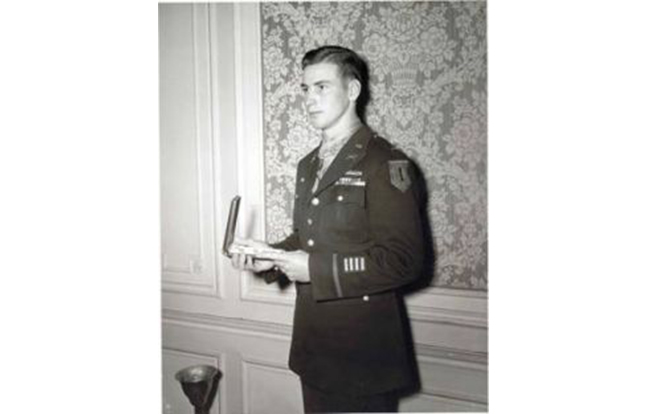
Rank and organization: Staff Sergeant, U.S. Army, 18th Infantry, 1st Infantry Division.
Place and dare: Near Goville, France; June 9-10, 1944.
Entered service at: Manhattan, Kan.
Birth: Junction City, Kan.
G.O. No.: 91, Dec. 19, 1944.
Citation: For conspicuous gallantry and intrepidity at the risk of his life above and beyond the call of duty on June 9-10, 1944, near Goville, France.
S/Sgt. Ehlers, always acting as the spearhead of the attack, repeatedly led his men against heavily defended enemy strong points exposing himself to deadly hostile fire whenever the situation required heroic and courageous leadership
Without waiting for an order, S/Sgt. Ehlers, far ahead of his men, led his squad against a strongly defended enemy strong point, personally killing four of an enemy patrol who attacked him en route. Then crawling forward under withering machine gun fire, he pounced upon the gun crew and put it out of action. Turning his attention to two mortars protected by the crossfire of two machine guns, Ehlers led his men through this hail of bullets to kill or put to flight the enemy of the mortar section, killing three men himself.
After mopping up the mortar positions, he again advanced on a machine gun, his progress effectively covered by his squad. When he was almost on top of the gun he leaped to his feet and, although greatly outnumbered, he knocked out the position single-handed. The next day, having advanced deep into enemy territory, the platoon of which Ehlers was a member, finding itself in an untenable position as the enemy brought increased mortar, machine gun, and small arms fire to bear on it, was ordered to withdraw.
Ehlers, after his squad had covered the withdrawal of the remainder of the platoon, stood up and by continuous fire at the semicircle of enemy placements, diverted the bulk of the heavy hostile fire on himself, thus permitting the members of his own squad to withdraw. At this point, though wounded himself, he carried his wounded automatic rifleman to safety and then returned fearlessly over the shell-swept field to retrieve the automatic rifle that he was unable to carry previously. After having his wound treated, he refused to be evacuated and returned to lead his squad. The intrepid leadership, indomitable courage, and fearless aggressiveness displayed by Ehlers in the face of overwhelming enemy forces serve as an inspiration to others.
*COLE, ROBERT G.
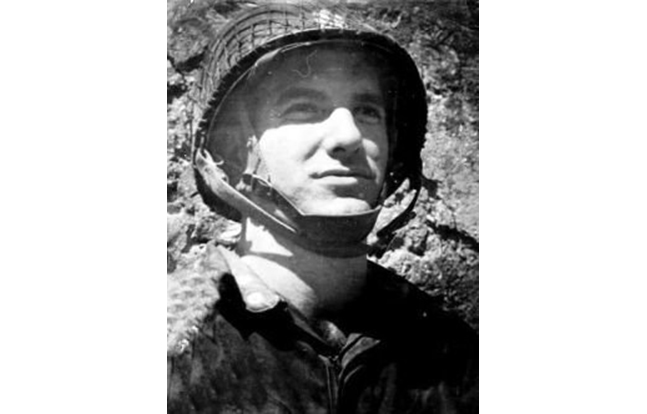
Rank and organization: Lieutenant Colonel, U.S. Army, 101st Airborne Division.
Place and date: Near Carentan, France; June 11, 1944.
Entered service at: San Antonio, Texas.
Birth: Fort Sam Houston, Texas.
G.O. No.: 79, Oct. 4, 1944.
Citation: For gallantry and intrepidity at the risk of his own life, above and beyond the call of duty on June 11, 1944, in France.
Lt. Col. Cole was personally leading his battalion in forcing the last four bridges on the road to Carentan when his entire unit was suddenly pinned to the ground by intense and withering enemy rifle, machine gun, mortar, and artillery fire placed upon them from well-prepared and heavily fortified positions within 150 yards of the foremost elements.
After the devastating and unceasing enemy fire had for more than one hour prevented any move and inflicted numerous casualties, Cole, observing this almost hopeless situation, courageously issued orders to assault the enemy positions with fixed bayonets. With utter disregard for his own safety and completely ignoring the enemy fire, he rose to his feet in front of his battalion and with drawn pistol shouted to his men to follow him in the assault.
Catching up a fallen man’s rifle and bayonet, he charged on and led the remnants of his battalion across the bullet-swept open ground and into the enemy position. His heroic and valiant action in so inspiring his men resulted in the complete establishment of our bridgehead across the Douve River. The cool fearlessness, personal bravery, and outstanding leadership displayed by Cole reflect great credit upon himself and are worthy of the highest praise in military service.
*DEFRANZO, ARTHUR F.
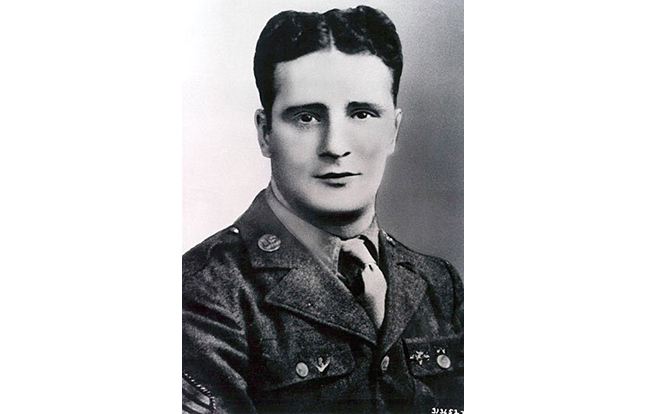
Rank and organization: Staff Sergeant, U.S. Army, 1st Infantry Division.
Place and date: Near Vaubadon, France; June 10, 1944.
Entered service at: Saugus, Mass.
Birth: Saugus, Mass.
G.O. No.: 1, Jan. 4, 1945.
Citation: For conspicuous gallantry and intrepidity at the risk of his life, above and beyond the call of duty, on June 10, 1944, near Vaubadon, France.
As scouts were advancing across an open field, the enemy suddenly opened fire with several machine guns and hit one of the men. S/Sgt. DeFranzo courageously moved out in the open to the aid of the wounded scout and was himself wounded, but brought the man to safety. Refusing aid, DeFranzo reentered the open field and led the advance upon the enemy. There were always at least two machine guns bringing unrelenting fire upon him, but DeFranzo kept going forward, firing into the enemy, and one by one the enemy emplacements became silent.
While advancing he was again wounded. Still, he continued on until he was within 100 yards of the enemy position and even as he fell, he kept firing his rifle and waving his men forward. When his company came up behind him, DeFranzo, despite his many severe wounds, suddenly raised himself and once more moved forward in the lead of his men until he was again hit by enemy fire.
In a final gesture of indomitable courage, he threw several grenades at the enemy machine gun position and completely destroyed the gun. In this action, DeFranzo lost his life, but by bearing the brunt of the enemy fire in leading the attack, he prevented a delay in the assault that would have been of considerable benefit to the foe and he made possible his company’s advance with a minimum of casualties. The extraordinary heroism and magnificent devotion to duty displayed by DeFranzo was a great inspiration to all about him and is in keeping with the highest traditions of the armed forces.
*KELLY, JOHN D.
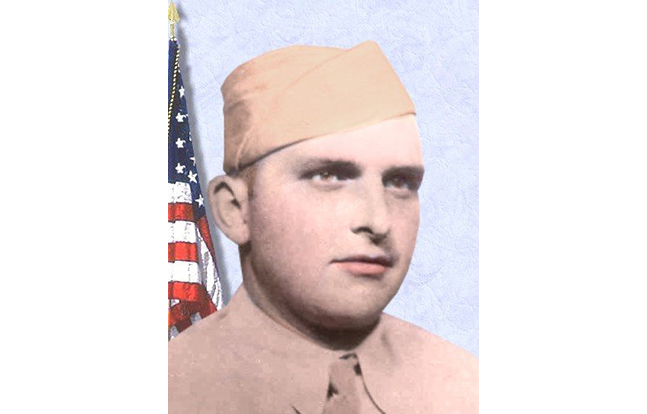
Rank and organization: Technical Sergeant (then Corporal), U.S. Army, Company E, 314th Infantry, 79th Infantry Division.
Place and date: Fort du Roule, Cherbourg, France; June 25, 1944.
Entered service at: Cambridge Springs, Pa.
Birth: Venango Township, Pa.
G.O. No.: 6, Jan. 24, 1945.
Citation: For conspicuous gallantry and intrepidity at the risk of his life above and beyond the call of duty.
On June 25, 1944, in the vicinity of Fort du Roule, Cherbourg, France, when Cpl. Kelly’s unit was pinned down by heavy enemy machine gun fire emanating from a deeply entrenched strongpoint on the slope leading up to the fort, Kelly volunteered to attempt to neutralize the strongpoint. Arming himself with a pole charge about 10 feet long and with 15 pounds of explosive affixed, he climbed the slope under a withering blast of machine gun fire and placed the charge at the strongpoint’s base. The subsequent blast was ineffective, and again, alone and unhesitatingly, he braved the slope to repeat the operation. This second blast blew off the ends of the enemy guns.
Kelly then climbed the slope a third time to place a pole charge at the strongpoint’s rear entrance. When this had been blown open he hurled hand grenades inside the position. It forced survivors of the enemy gun crews to come out and surrender. The gallantry, tenacity of purpose, and utter disregard for personal safety displayed by Kelly were an incentive to his comrades and worthy of emulation by all.
*MONTEITH, JIMMIE W., JR.
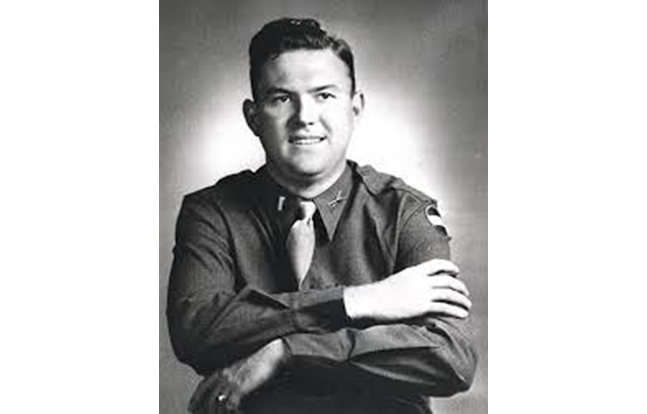
Rank and organization: First Lieutenant, U.S. Army, 16th Infantry, 1st Infantry Division.
Place and date: Near Colleville-sur-Mer, France; June 6, 1944.
Entered service at: Richmond, Va.
Born: July 1, 1917, Low Moor, Va.
G.O. No.: 20, March 29, 1945.
Citation: For conspicuous gallantry and intrepidity above and beyond the call of duty on D-Day, June 6, 1944, near Colleville-sur-Mer, France.
1st Lt. Monteith landed on D-Day with the initial assault waves on the coast of France under heavy enemy fire. Without regard to his own personal safety, he continually moved up and down the beach reorganizing men for further assault. He then led the assault over a narrow protective ledge and across the flat, exposed terrain to the comparative safety of a cliff. Retracing his steps across the field to the beach, he moved over to where two tanks were buttoned up and blind under violent enemy artillery and machine gun fire.
Completely exposed to the intense fire, Monteith led the tanks on foot through a minefield and into firing positions. His direction led to the destruction of several enemy positions. He then rejoined his company and under his leadership, his men captured an advantageous position on the hill. Supervising the defense of his newly won position against repeated vicious counterattacks, he continued to ignore his own personal safety, repeatedly crossing the 200 or 300 yards of open terrain under heavy fire to strengthen links in his defensive chain. When the enemy succeeded in completely surrounding Monteith and his unit and while leading the fight out of the situation, Monteith was killed by enemy fire. The courage, gallantry, and intrepid leadership displayed by Monteith are worthy of emulation.
OGDEN, CARLOS C.
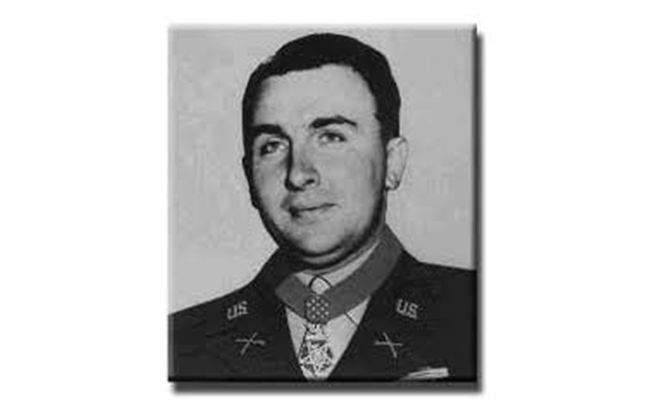
Rank and organization: First Lieutenant, U.S. Army, Company K, 314th Infantry, 79th Infantry Division.
Place and date: Near Fort du Roule, France; June 25, 1944.
Entered service at: Fairmont, Ill.
Born: May 19, 1917, Borton, Ill.
G.O. No.: 49, June 28, 1945.
Citation: On the morning of June 25, 1944, near Fort du Roule, guarding the approaches to Cherbourg, France, 1st Lt. Ogden’s company was pinned down by fire from a German 88-mm. gun and two machine guns.
Arming himself with an M-1 rifle, a grenade launcher, and a number of rifle and hand grenades, he left his company in position and advanced alone, under fire, up the slope toward the enemy emplacements.
Struck on the head and knocked down by a glancing machine gun bullet, Ogden, in spite of his painful wound and enemy fire from close range, continued up the hill. Reaching a vantage point, he silenced the 88mm. gun with a well-placed rifle grenade. Then, with hand grenades, he knocked out the two machine guns, again being painfully wounded. Ogden’s heroic leadership and indomitable courage in alone silencing these enemy weapons inspired his men to greater effort and cleared the way for the company to continue the advance and reach its objectives.
*PEREGORY, FRANK D.
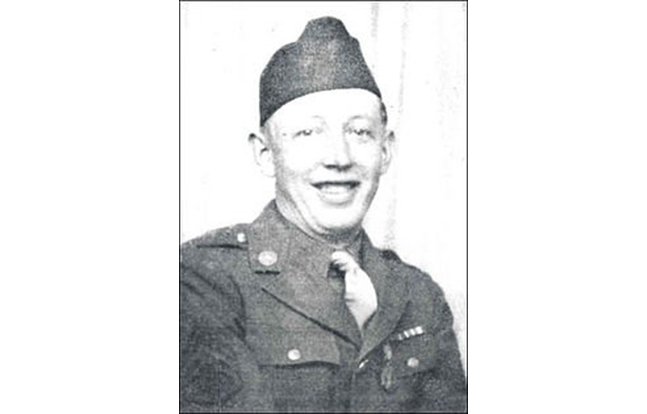
Rank and organization: Technical Sergeant, U.S. Army, Company K 116th Infantry, 29th Infantry Division.
Place and date: Grandcampe France; June 8, 1944.
Entered service at: Charlottesville, Va.
Born: April 10, 1915, Esmont, Va.
G.O. No.: 43, May 30, 1945.
Citation: On June 8, 1944, the 3rd Battalion of the 116th Infantry was advancing on the strongly held German defenses at Grandcampe, France, when the leading elements were suddenly halted by decimating machine gun fire from a firmly entrenched enemy force on the high ground overlooking the town.
After numerous attempts to neutralize the enemy position by supporting artillery and tank fire had proved ineffective, T/Sgt. Peregory, on his own initiative, advanced up the hill under withering fire and worked his way to the crest where he discovered an entrenchment leading to the main enemy fortifications 200 yards away. Without hesitating, he leaped into the trench and moved toward the emplacement.
Encountering a squad of enemy riflemen, he fearlessly attacked them with hand grenades and bayonet. He killed eight and forced three to surrender. Continuing along the trench, he single-handedly forced the surrender of 32 more riflemen, captured the machine gunners, and opened the way for the leading elements of the battalion to advance and secure its objective. The extraordinary gallantry and aggressiveness displayed by Peregory are exemplary of the highest tradition of the armed forces.
*PINDER, JOHN J., JR.
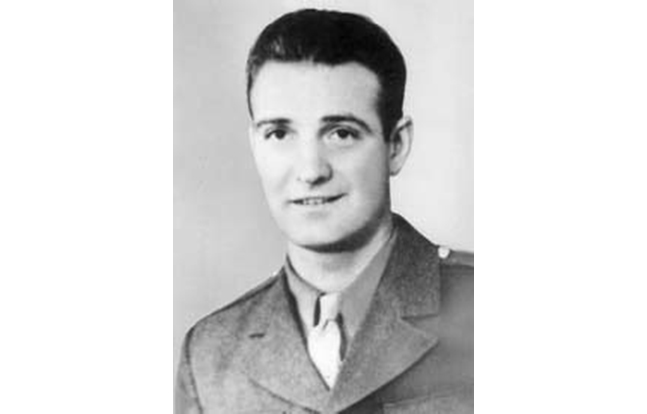
Rank and organization: Technician Fifth Grade, U.S. Army, 16th Infantry, 1st Infantry Division.
Place and date: Near Colleville-sur-Mer, France; June 6, 1944.
Entered service at: Burgettstown, Pa.
Birth: McKees Rocks, Pa.
G.O. No.: 1, Jan. 4, 1945.
Citation: For conspicuous gallantry and intrepidity above and beyond the call of duty on D-Day, June 6, 1944, near Colleville-sur-Mer, France.
On D-Day, Technician 5th Grade Pinder landed on the coast 100 yards off shore under devastating enemy machine gun and artillery fire which caused severe casualties among the boatload. Carrying a vitally important radio, he struggled towards shore in waist-deep water.
Only a few yards from his craft he was hit by enemy fire and was gravely wounded, but Pinder never stopped. He made shore and delivered the radio. Refusing to take cover afforded or to accept medical attention for his wounds, Pinder, though terribly weakened by the loss of blood and in fierce pain, on three occasions went into the fire-swept surf to salvage communication equipment. He recovered many vital parts and equipment, including another workable radio. On the third trip, he was again hit, suffering machine gun bullet wounds in the legs. Still, this valiant soldier would not stop for rest or medical attention.
Remaining exposed to heavy enemy fire, growing steadily weaker, he aided in establishing the vital radio communication on the beach. While so engaged this dauntless soldier was hit for the third time and killed. The indomitable courage and personal bravery of Pinder shown on D-Day were a magnificent inspiration to the men with whom he served.
*ROOSEVELT, THEODORE, JR.
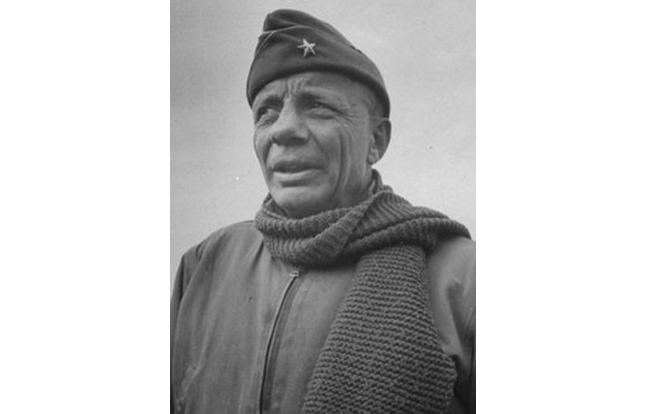
Rank and organization: brigadier general, U.S. Army.
Place and date: Normandy invasion; June 6, 1944.
Entered service at: Oyster Bay, N.Y.
Birth: Oyster Bay, N.Y.
G.O. No.: 77, Sept. 28, 1944.
Citation: for gallantry and intrepidity at the risk of his life above and beyond the call of duty on D-Day, June 6, 1944, in France.
After two verbal requests to accompany the leading assault elements in the Normandy D-Day invasion had been denied, Brig. Gen. After having his written request for this mission approved, Roosevelt landed with the first wave of the forces assaulting the enemy-held beaches. He repeatedly led groups from the beach, over the seawall, and established them inland. His valor, courage, and presence in the very front of the attack and his complete unconcern at being under heavy fire inspired the troops to heights of enthusiasm and self-sacrifice.
Although the enemy had the beach under constant direct fire, Roosevelt moved from one locality to another, rallying men around him. He directed and personally led them against the enemy. Under his seasoned, precise, calm, and unfaltering leadership, assault troops reduced beach strong points and rapidly moved inland with minimum casualties. Thusly, he contributed substantially to D-Day and the successful establishment of the beachhead in France.
